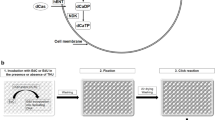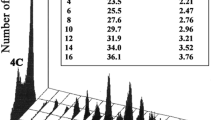Abstract
Cellular and biochemical analyses of the toxic effects of the thymidine analog, 5-hydroxymethyl-2′-deoxyuridine (hmdUrd), were carried out using V79.5 Chinese hamster cells. It was found that the toxic effects of hmdUrd could be totally suppressed by the addition of thymidine at 1/10th the concentration of hmdUrd. When other pyrimidines were tested, deoxyuridine was found to also suppress toxicity, although not as well as thymidine, while orotate, uridine, cytidine, and deoxycytidine did not have significant effect. Biochemical analyses of the metabolic fate of hmdUrd demonstrated low but significant levels of hmdUrd triphosphate and the incorporation of 5-hydroxymethyluracil (hmUra) residues into DNA. Surprisingly, in addition to these metabolites, relatively high levels of free hmUra were also detected in the acid-soluble cell extracts. Further analysis demonstrated that when V79.5 cells were exposed to hmdUrd significant amounts of hmUra were released into the culture medium. In vitro assays provided evidence that hmdUrd was first phosphorylated to its monophosphate and then degraded to hmUra, possibly via the action of a new enzyme, hydroxymethyldeoxyuridylate phosphorylase. Exposure of cells to hmUra alone, at concentrations as high as 3 mM, had no effect on viability. However, when V79.5 cells were simultaneously exposed to low, nontoxic concentrations of hmdUrd and high, nontoxic concentrations of hmUra, a synergistic reduction in viability was observed. This synergistic effect was found to correlate with increased incorporation of hmUra into DNA, possibly via end-product inhibition of an hmUra-DNA glycosylase.
Similar content being viewed by others
Literature cited
Kallen, R.G., Simon, M., and Marmur, J. (1962).J. Mol. Biol. 5:248–250.
Rae, P.M.M. (1973).Proc. Natl. Acad. Sci. U.S.A. 70:1141–1145.
Rae, P.M.M. (1976).Science 194:1062–1064.
Kaufman, E.R., and Davidson, R.L. (1977).Somat. Cell Genet. 3:649–661.
Waschke, S., Reefschlager, J., Barwolff, D., and Langen, P. (1975).Nature 255:629–630.
Matthes, E., Barwolff, D., Preussel, B., and Langen, P. (1979). InAntimetabolites in Biochemistry, Biology and Medicine, (eds.). Skoda, J., and Langen, P. (eds.). (Pergamon Press, Oxford), pp. 115–126.
Cadet, J., and Teoule, R. (1975).Bull. Soc. Chim. Fr. 3–4:891–895.
Myers, L.S., Jr., Ward, J.F., Tsukamoto, W.T., Holmes, D.E., and Julca, J.R. (1965).Science 148:1234–1235.
Teebor, G.W., Frenkel, K., and Goldstein, M.S. (1982).Adv. Enzyme Regul. 20:39–54.
Teebor, G.W., Frenkel, K., and Goldstein, M.S. (1984).Proc. Natl. Acad. Sci. U.S.A. 81:318–321.
Hollstein, M.C., Brooks, P., Linn, S., and Ames, B.N. (1984).Proc. Natl. Acad. Sci. U.S.A. 81:4003–4007.
Ford, D.K., and Yerganian, G. (1958).J. Natl. Cancer Inst. 21:393–425.
Kit, S., Dubbs, D.R., Piekarski, L.J., and Hsu, T.C. (1963).Exp. Cell Res. 31:297–312.
Khym, J.X. (1975).Clin. Chem. N.Y. 21:1245–1252.
Adelstein, S.J., Baldwin, C., and Kohn, H.I. (1971).Dev. Biol. 26:537–546.
Moore, G. (1964).Exp. Cell Res. 36:422–423.
Kao, F.T., and Puck, T.T. (1968).Proc. Natl. Acad. Sci. U.S.A. 60:1275–1281.
Cohen, S.S., Flaks, J.G., Barner, H.D., Loeb, M.R., and Lichtenstein, J. (1958).Proc. Natl. Acad. Sci. U.S.A. 44:1004–1012.
Wataya, Y., Santi, D.V., and Hansch, C. (1977).J. Med. Chem. 20:1469–1473.
Kaufman, E.R., and Davidson, R.L. (1979).Exp. Cell Res. 123:355–363.
Danenberg, P.V. (1977).Biochim. Biophys. Acta 473:73–92.
Lindahl, T. (1982).Annu. Rev. Biochem. 51:61–87.
Author information
Authors and Affiliations
Rights and permissions
About this article
Cite this article
Kaufman, E.R. Biochemical analysis of toxic effects of 5-hydroxymethyl-2′-deoxyuridine in mammalian cells. Somat Cell Mol Genet 12, 501–512 (1986). https://doi.org/10.1007/BF01539921
Received:
Issue Date:
DOI: https://doi.org/10.1007/BF01539921




